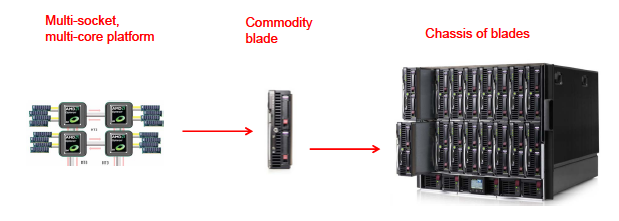When I first started hearing SAS CEO Jim Goodnight talk about high-performance analytics (HPA), I was fascinated. But I have to admit that my mind was spinning a bit from the terminology: blades, cores, captains, generals and so on.
But then the metaphorical nature of these terms clicked for me, and I'm just enough of a language geek to get a kick out of the metaphors we use to describe technology.
In this post, I'm attempting to dig into the comparisons in those metaphors, and to analyze the use of common words to help us describe and understand something new. For caveats, keep in mind that I'm no linguist or computer scientist, and this is surely an incomplete list. I'll start with this image that I found in a recent HPA presentation by Oliver Schabenberger and Radhika Kulkarni, two HPA experts at SAS.
4 high-performance metaphors seen here
Socket - In electronics, a socket connects an electronic device to its power source. In biology, a socket is a cavity for, say, your teeth or eyes. In computing, a socket is an end-point in network communication.
Core - In geology, the core is the center part of the earth. In literature and epistemology, the core is the most essential point. In computing, the core is the processor that executives program instructions, such as add, move data, branch data or compute analysis. In high-performance computing, multiple cores work together to run multiple instructions at the same time.
Blade - In common usage, a blade is the sharp edge of a tool. In computing, a blade is one of a series of individual computers or servers that are housed together in one large configuration. Each blade in the configuration can operate independently, or they can work together to break down and process one large task in parallel.
Chassis - In automotive engineering, the chassis is the framework of the car's body. In electronics, the chassis is the metal frame where electronics and circuit boards are mounted for televisions and radios. In high-performance computing, the chassis is the rack that holds the collection of blades.
4 more high-performance metaphors you often hear
Node - In biology and anatomy a node is a mass of tissue, like a lymph node. In botany it is a joint in the stem, often where the stem bears a leaf. In computing, a node is a point of intersection or connection in a network.
Thread - In common usage, thread is a light string used for sewing. In computing, threads are the individual pieces of instruction that get executed by an operating system or core. Multi-threading is the act of running multiple processes at the same time.
Captain - In the military, public safety and on board various vessels, captains are officers in charge of individual units. In high-performance analytics, the captain is the compute node that tells individual cores what to calculate. It is also frequently referred to as the worker node.
General - In the military, generals are high-ranking officers that command multiple units or platoons. In high-performance analytics, the general node is the head node that controls the overall equation and commands each captain to go out and process their piece of the larger problem. Another common name for this node is the queen node.
Just thinking about these metaphors has helped me understand high-performance analytics more than I did before. Essentially, the General nodes process threads of code by sending directions to the Captain nodes. The Captain nodes send information to the cores, which run the calculations and then send answers back through the chain for a final answer.
For more technical details on the hierarchy of nodes, sockets and cores, I recommend the post Nodes, Sockets, Cores and Flops, Oh My from Dell. Another archived post from SAS CTO Keith Collins offers good descriptions of how these components work together in different configurations for high-performance analytics.
This is day seven of my "HPA once a day" blog post series. To read more, see all of the high-performance analytics posts on this blog or follow the high-performance analytics rss feed.
You'll also find more answers and definitions in this special 32-page report on high-performance analytics.


6 Comments
I first heard Dr. Goodnight talk about high-performance analytics during SAS Global Forum 2009. It was so exciting to see the possibilities. I've been writing about high-performance analytics and the wonderful possibilities since that extraordinary presentation, but I've never heard or read such a complete description of the parts and pieces that make this technological magic happen for SAS customers. Great post!!
Thanks, Waynette. I keep thinking of more and more metaphors to add to the list, but this is at least a start!
want some more?
Broadcast
Scatter
Gather
Reduce/reduction
Lock
Event
Semaphore
just a few that spring to mind. 🙂
Pingback: Managing big data at the speed of risk - SAS Users Groups
Pingback: What’s new with in-memory computing? - SAS Voices
Pingback: Big data answers for your industry and your role - SAS Voices